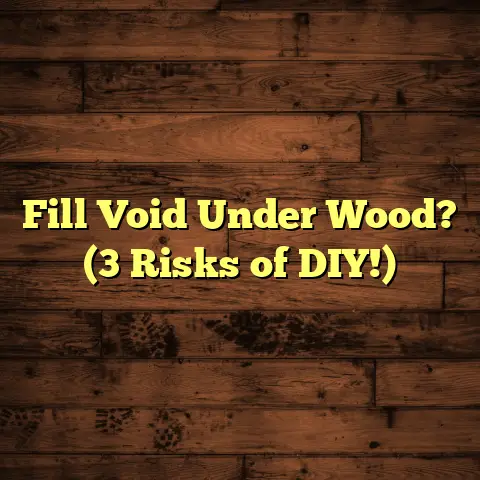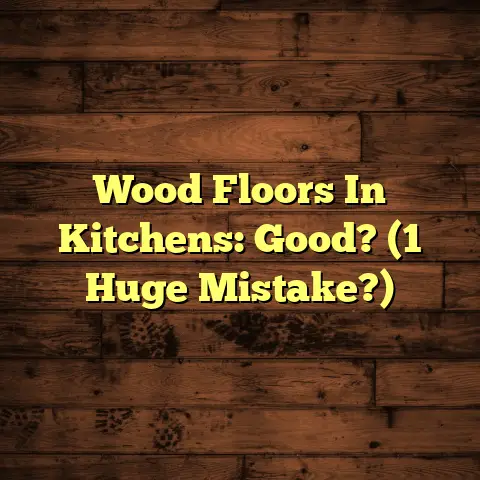How To Create A Functional Mudroom Space?
Boosting Resale Value and Enhancing Home Functionality
I’m a flooring contractor, and I’ve seen firsthand how a well-designed mudroom can transform a home.
It’s not just about having a place to kick off your boots – it’s about adding serious value and making your life easier.
In today’s market, buyers are craving functional spaces, and the mudroom is quickly becoming a must-have.
Think about it: a designated spot to corral the chaos of daily life, keeping your main living areas clean and organized.
A mudroom isn’t just a practical space; it’s an integral part of your home’s aesthetic and marketability.
Let’s dive into how you can create a mudroom that not only serves its purpose but also boosts your home’s resale value.
Section 1: Understanding the Importance
of a Mudroom
1.1 Definition and Purpose
So, what exactly is a mudroom?
Simply put, it’s a transitional space between the outdoors and indoors.
It’s your first line of defense against dirt, mud, snow, and all the other elements that try to sneak into your home.
The primary functions are pretty straightforward:
- Providing a designated spot to remove and store shoes, coats, and other outdoor gear.
- Organizing belongings like backpacks, sports equipment, and pet supplies.
- Reducing clutter in the main living areas of your home.
I’ve seen families transform cluttered hallways and entryways into organized havens simply by adding a well-planned mudroom.
It’s amazing what a difference it can make!
1.2 Market Trends
Are mudrooms really that popular?
You bet they are!
Real estate trends are showing a clear preference for homes with functional entryways, and mudrooms are leading the charge.
According to a recent survey by the National Association of Home Builders (NAHB), over 70% of homebuyers want a mudroom or designated drop zone (Source: NAHB, What Home Buyers Really Want, 2023).
I’ve heard real estate agents say things like, “A mudroom can be a major selling point, especially for families with kids or pets.”
I had a client who was struggling to sell their home until they added a small but well-designed mudroom.
Within weeks, they had multiple offers!
It’s not just about having any mudroom, though.
It needs to be functional and appealing.
1.3 Functionality vs. Aesthetics
Here’s the thing: a mudroom needs to be both practical and aesthetically pleasing.
No one wants to walk into a drab, disorganized space, even if it is functional.
The key is finding the right balance between functionality and aesthetics.
Think about it: a beautiful bench with hidden storage, stylish hooks for coats, and a durable, eye-catching floor.
These elements not only serve a purpose but also enhance the overall look and feel of your home.
I always tell my clients that the mudroom is the first impression guests get of your home, so make it count.
A well-designed mudroom can elevate the entire property.
Section 2: Designing Your Mudroom
2.1 Space Planning
Alright, let’s get down to the nitty-gritty of mudroom design.
First things first: where should you put it?
The ideal location is usually near an entry point that gets a lot of traffic, such as the garage entrance, side door, or back door.
Consider factors like accessibility and traffic flow.
You want it to be convenient for your family to use every day.
Do you have a dedicated room that you can convert into a mudroom?
Or are you working with a smaller space, like a nook or hallway?
Different layouts will work best depending on the available space.
For a dedicated room, you might consider a U-shaped or L-shaped layout.
If you’re working with a smaller space, a straight layout with built-in storage along one wall might be the best option.
I’ve helped clients transform awkward corners into functional mudroom spaces simply by getting creative with the layout.
2.2 Essential Features
What are the must-have features of a functional mudroom?
Here’s a list to get you started:
- Storage Solutions: Cabinets, shelves, drawers, and cubbies are essential for storing shoes, coats, hats, gloves, and other outdoor gear.
- Hooks: These are great for hanging frequently used items like jackets, backpacks, and dog leashes.
- Benches: A bench provides a convenient spot to sit and remove shoes, and it can also double as storage space if you choose a bench with built-in storage.
- Flooring: Choose a durable, water-resistant flooring material that can withstand heavy foot traffic and spills.
- Lighting: Good lighting is essential for visibility and safety. Consider a combination of ambient lighting (like recessed lights) and task lighting (like a pendant light over the bench).
Each of these features plays a crucial role in enhancing the usability of your mudroom.
I always recommend starting with storage solutions.
The more storage you have, the easier it will be to keep the space organized.
2.3 Customization
Here’s where you can really let your personality shine!
Don’t be afraid to customize your mudroom to fit your family’s specific needs and style.
Do you have kids who play sports?
Consider adding a designated area for storing sports equipment.
Do you have pets?
Include a pet washing station or a storage area for pet supplies.
Custom-built furniture or modular solutions can be a great way to maximize space and create a mudroom that is tailored to your needs.
I worked with a family who had a passion for hiking.
We designed a custom mudroom with a built-in boot dryer and a wall-mounted rack for their hiking poles.
They loved it!
Remember, the goal is to create a space that reflects your style while remaining practical and functional.
Section 3: Selecting Materials and Finishes
3.1 Durable Flooring Options
Let’s talk flooring!
This is one of the most important decisions you’ll make when designing your mudroom.
You need a material that is durable, water-resistant, and easy to maintain.
Here are some of the best options:
- Tile: Tile is a classic choice for mudrooms because it’s incredibly durable, water-resistant, and easy to clean. Porcelain tile is an especially good option because it’s very dense and less porous than other types of tile.
- Vinyl: Vinyl flooring is another great option for mudrooms because it’s affordable, water- resistant, and easy to install. Luxury vinyl plank (LVP) is a popular choice because it looks like real wood but is much more durable and water- resistant.
- Laminate: Laminate flooring is a budget- friendly option that is also relatively durable and easy to clean. However, it’s not as water-resistant as tile or vinyl, so it’s important to choose a high-quality laminate that is specifically designed for use in wet areas.
- Hardwood: While hardwood flooring is beautiful and durable, it’s not the best choice for mudrooms because it’s susceptible to water damage. If you really want hardwood in your mudroom, consider using a very durable finish and be sure to clean up any spills immediately.
I always steer my clients towards tile or vinyl for mudrooms.
They offer the best combination of durability, water resistance, and ease of maintenance.
3.2 Wall Treatments
Don’t forget about the walls!
The right wall treatment can not only add to the overall design of your mudroom but also protect your walls from dirt and scuffs.
Here are some popular options:
- Paint: Paint is a simple and affordable way to add color and personality to your mudroom. Choose a durable, scrubbable paint that can withstand frequent cleaning.
- Wallpaper: Wallpaper can add texture and pattern to your mudroom. Choose a wallpaper that is moisture-resistant and easy to clean.
- Beadboard: Beadboard is a classic wall treatment that adds a touch of charm to any space. It’s also relatively durable and easy to clean.
I personally love beadboard in mudrooms.
It adds a timeless, classic look that works well with a variety of styles.
3.3 Storage Solutions
The materials you choose for your storage solutions can have a big impact on the look and feel of your mudroom.
Wood is a classic choice that adds warmth and character to the space.
Metal is a more modern option that is durable and easy to clean.
Consider the overall style of your home when choosing storage materials.
If you have a traditional home, wood storage solutions might be the best choice.
If you have a more modern home, metal storage solutions might be a better fit.
I always tell my clients to choose materials that are both functional and aesthetically pleasing.
You want your mudroom to be a space that you enjoy spending time in, not just a place to stash your stuff.
Section 4: Maximizing Functionality
4.1 Smart Organization
Organization is key to a functional mudroom.
Without it, your mudroom will quickly become a dumping ground for clutter.
Here are some strategies for organizing your mudroom:
- Use Baskets and Bins: Baskets and bins are great for storing shoes, hats, gloves, and other small items.
- Label Everything: Labeling your baskets and bins will help you keep track of what’s inside.
- Create Designated Areas: Create designated areas for shoes, coats, backpacks, and other items.
I’m a big fan of using clear bins so you can easily see what’s inside.
It makes it much easier to find what you’re looking for.
4.2 Seasonal Adjustments
Your mudroom needs to be able to adapt to seasonal changes.
In the winter, you’ll need plenty of space for storing coats, hats, gloves, and scarves.
In the summer, you’ll need a place to store beach towels, sunscreen, and other summer essentials.
Consider adding extra hooks for winter coats or summer gear.
You might also want to swap out your winter boots for sandals and flip-flops.
Flexibility is key to a functional mudroom.
I always tell my clients to think about how they use their mudroom throughout the year and design the space accordingly.
4.3 Maintenance Tips
Keeping your mudroom clean and organized is essential for long-term functionality.
Here are some tips for maintaining your mudroom:
- Wipe Up Spills Immediately: Spills can stain your flooring and walls, so it’s important to wipe them up as soon as they happen.
- Sweep or Vacuum Regularly: Sweep or vacuum your mudroom regularly to remove dirt and debris.
- Declutter Regularly: Declutter your mudroom regularly to prevent it from becoming a dumping ground for clutter.
I recommend setting aside a few minutes each week to clean and organize your mudroom.
It will make a big difference in the long run.
Section 5: Mudroom Decor and Accessories
5.1 Color Schemes and Themes
Choosing the right color palette can make a big difference in the overall look and feel of your mudroom.
Consider choosing a color palette that complements the rest of your home.
You might also want to choose a color palette that is both practical and stylish.
Neutral colors like gray, beige, and white are always a good choice for mudrooms because they are easy to clean and won’t show dirt as easily as darker colors.
I personally love using pops of color in mudrooms.
A bright-colored bench or a fun patterned rug can add personality to the space.
5.2 Decorative Elements
Don’t forget about the decorative elements!
Artwork, mirrors, and plants can all add to the overall appeal of your mudroom.
A mirror can make a small mudroom feel larger and more open.
Plants can add a touch of nature to the space and help to purify the air.
I always recommend adding a personal touch to your mudroom.
Hang a family photo or display a favorite piece of artwork.
5.3 Seasonal Decor
Seasonal decorations can keep your mudroom fresh and appealing throughout the year.
In the fall, you might want to add pumpkins, gourds, and fall foliage.
In the winter, you might want to add holiday lights, garland, and ornaments.
In the spring, you might want to add flowers, plants, and pastel-colored decorations.
I love changing up my mudroom decor with the seasons.
It’s a fun and easy way to keep the space feeling fresh and inviting.
Conclusion
So, there you have it!
Creating a functional mudroom space is an investment in your home that combines practicality with style.
A well-designed mudroom can significantly increase your home’s resale value and make your life easier.
Remember, thoughtful design and attention to detail can create a space that not only serves daily needs but also enhances the overall marketability of your property.
Don’t be afraid to get creative and personalize your mudroom to fit your family’s specific needs and style.
With a little planning and effort, you can create a mudroom that is both functional and beautiful.





